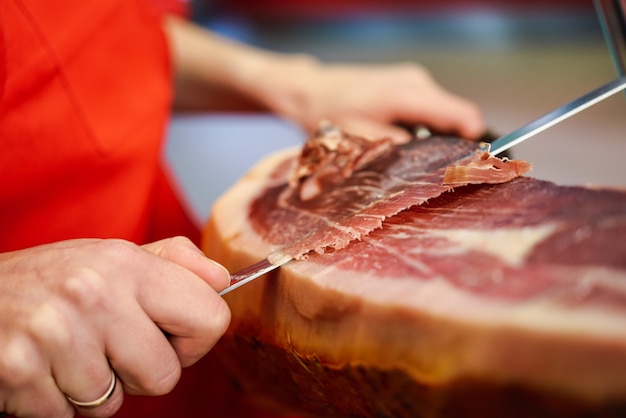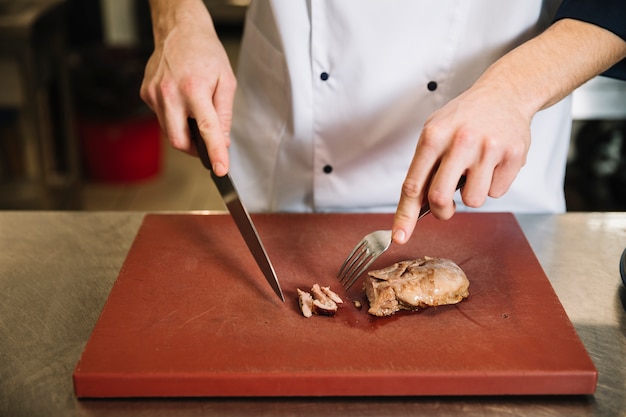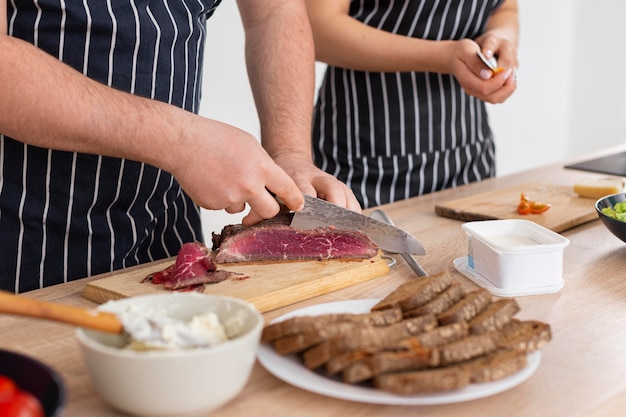So you're thinking about tackling brisket, eh? You've heard the whispers, seen the drool-worthy photos, and maybe even experienced the heavenly melt-in-your-mouth texture of a perfectly cooked brisket. It's a real showstopper, a crowd-pleaser, and a true test of your barbecue skills. Now, I'm not going to lie, it can be a bit daunting, especially if you're a beginner. You've got all this talk about smoking times, trimming techniques, and all sorts of jargon flying around. But don't worry, I'm here to break it down for you, step by step. This is your ultimate guide to conquering brisket, from the initial purchase to that glorious, melt-in-your-mouth bite. So, grab a brew, settle in, and let's get this brisket party started!
(Part 1) Choosing Your Brisket

The Cut of Choice: Understanding Brisket
First things first, you've got to pick the right cut. Now, brisket isn't just one piece of meat. It's actually two muscles – the flat and the point. Think of it like a team – they work together to create the ultimate brisket experience. The flat is the leaner, more rectangular muscle, often likened to a "steak" texture. It's the reliable player, providing a sturdy base for your brisket. Then you've got the point, which is rounder, fattier, and becomes beautifully tender with slow cooking. It's the star player, adding richness and succulence. Most butchers sell whole briskets, which combine the flat and point, giving you the best of both worlds. It's like having a dynamic duo on your barbecue team.
If you want to be a real pro, ask for a "packer cut," which is a whole brisket with a thick layer of fat on top. This fat is a real game-changer, adding flavor and moisture during cooking. Imagine a protective blanket of goodness keeping your brisket moist and juicy. If you prefer a bit less fat, you can ask for a "trimmed packer cut," where some of the fat has been removed.
Brisket Buying Tips
Now, you want a brisket that's got good marbling – those little white streaks of fat running through the meat. It's like a network of flavor veins, adding depth and richness to your brisket. You want a brisket that's got a nice even red color, not too dark or too light. A vibrant red hue indicates freshness. Give it a good sniff, and it should smell fresh, not funky. And don't forget to weigh it! A good brisket for a family of four will be about 10-12 pounds. Now, don't feel like you need to rush into it. Take your time, find the perfect brisket, and get ready to rock this cooking challenge.
(Part 2) Prepping Your Brisket

Trimming the Fat: A Strategic Approach
Now, before you even think about throwing your brisket on the grill, it needs a bit of TLC. We're gonna trim that fat, mate. I like to leave about a ??-inch layer of fat on top, because it'll melt and baste the meat during cooking. Imagine that fat turning into a liquid gold, infusing your brisket with flavor. But you can trim it closer if you prefer, it's really a matter of personal preference. Now, there's a bit of a debate about the fat on the side, but I like to leave that on too. It helps keep the brisket moist and tender. Think of it as a protective barrier, keeping the moisture locked in.
Rub It In: Your Secret Weapon
Now, here's where you get to be creative. This is where you apply your rub, and let me tell you, there's no right or wrong way to do it. You can use a pre-made rub, or you can whip up your own. It's your chance to unleash your inner culinary artist. I tend to go for a good mix of paprika, salt, pepper, garlic powder, onion powder, and a bit of brown sugar. Get in there with your hands, massage that rub right into the brisket, making sure you coat the whole thing evenly. Think of it as a hug for your brisket, infusing it with flavor.
(Part 3) The Smoke Show: Choosing Your Smoker

Smoker Choices: Gas, Charcoal, Offset – Finding Your Match
Now, there's a world of smokers out there. It's like choosing your barbecue partner – each one brings its own personality and flavor. Gas smokers are the easiest to use, they heat up quickly, and you can control the temperature pretty easily. It's like having a reliable teammate, always ready to get the job done. charcoal smokers give you a more traditional, smoky flavor, but they can be a bit trickier to control. Think of it as the seasoned veteran, requiring a bit more attention, but delivering that classic smoky goodness. Then you've got offset smokers, which are a bit more hands-on but produce some seriously impressive results. They're like the maverick, demanding your full attention, but rewarding you with an unparalleled flavor. It's like choosing a football team - it all comes down to personal preference. But trust me, whatever you choose, you're gonna be in for a treat.
Setting Up Your Smoker: Prepping for the Long Haul
Right, now we're getting down to business. Load up your smoker with charcoal or wood chunks, get it up to temperature, and let it settle in. You're looking for a nice steady temperature between 225 and 250 degrees Fahrenheit. Think of this as creating the perfect environment for your brisket to cook slowly and evenly. And here's a little trick: if you're using charcoal, add a few pieces of wood like hickory, pecan, or apple to give your brisket that smoky aroma. It's like adding a dash of magic, infusing your brisket with a touch of woodsy charm.
(Part 4) The Smoking Game: Getting Started
The First Smoke: The Crucial Hours
Okay, you've got your smoker set up, your brisket prepped, and you're ready to roll. Now, the first few hours are crucial. Think of it as the opening act, setting the stage for a delicious finale. You want to keep the smoker at a steady temperature, around 225-250 degrees Fahrenheit, and let that brisket cook slow and steady. It's gonna take a while – about 6 to 8 hours for a 10-12 pound brisket.
Spritzing and Wrapping: A Moisture Boost
Now, here's where things get interesting. You're gonna want to spritz your brisket every hour or so with a mixture of apple cider vinegar and water. This helps keep the brisket moist and adds a bit of tangy flavor. Imagine a refreshing mist, keeping your brisket hydrated and adding a touch of zest. After about 4 hours, you're gonna want to wrap it. I like to use butcher paper, but you can also use aluminum foil. Wrapping traps in the moisture and helps the brisket cook evenly. It's like a warm hug, keeping your brisket cozy and tender.
(Part 5) The Stalling Stage: Don’t Panic!
The Stalling Stage: What it is and How to Handle it
You're probably thinking, "What's stalling?" Well, here's the deal. At some point during the cooking process, the internal temperature of the brisket will plateau, even though it's still in the smoker. Don't panic! It's a natural part of the process. It's like the meat is saying, "Hold on, I need a minute to rest and absorb all this delicious flavor." This stalling stage can last for a few hours, but eventually, the temperature will start rising again.
The Probe Test: Checking for Doneness
Right, you've been waiting patiently, the brisket has been smoking for hours, and now you're starting to wonder, "Is it done yet?" Well, there's a surefire way to tell. You've got to use a meat thermometer, and you're looking for an internal temperature of at least 203 degrees Fahrenheit. It's like a secret code, revealing when your brisket is ready for its big reveal. You can also do a probe test. If the probe goes in easily, and the brisket feels tender, you're good to go. But be patient, you don't want to rush this process.
(Part 6) The Resting Ritual: Patience is Key
The Resting Stage: Letting the Brisket Relax
You've done it, you've smoked your brisket to perfection! But you're not done yet. It's time for the resting stage. This is crucial for allowing the juices to redistribute and the brisket to become even more tender. Imagine it as a time for relaxation, allowing the brisket to fully absorb its smoky goodness. I like to wrap the brisket in foil and let it rest for at least two hours. Some people even say to rest it for up to 4 hours. But trust me, your patience will be rewarded.
The Big Reveal: Slicing and Serving
Right, the moment of truth! You've waited patiently, the brisket has rested, and now it's time to slice and serve. Now, there's a bit of an art to slicing brisket. You want to slice it against the grain, which means slicing perpendicular to the direction the muscle fibers run. Think of it as slicing across the grain, creating tender and juicy bites. This helps create nice, tender slices.
(Part 7) Brisket Beyond the Basics
brisket sides: Pairing Perfection
Right, you've got your juicy brisket, but what about the sides? You can't go wrong with classics like baked beans, coleslaw, potato salad, and cornbread. They're like the supporting cast, adding their own unique flavors to the show. But if you want to go a bit fancier, you can try mac and cheese, green bean casserole, or even some sweet potato fries. It's your chance to add a touch of flair and elevate your brisket experience.
brisket leftovers: Delicious Second Chances
You've got a mountain of brisket left over? Don't fret, there's so much you can do with it! You can slice it up and make brisket sandwiches, or add it to soups, stews, or chili. You can even freeze some for later. Brisket is a real versatile meat, so get creative and don't let those leftovers go to waste. It's like a blank canvas, ready for your culinary imagination.
(Part 8) The Final Verdict: A brisket masterpiece
So there you have it, your ultimate guide to tender, juicy brisket. It's a journey, a bit of a challenge, but a real rewarding one. Now, you're not gonna get it perfect the first time, and that's okay. Keep practicing, keep experimenting, and you'll be a brisket master in no time. And remember, the most important thing is to enjoy the process, and enjoy the taste of your hard work. Cheers!
FAQs
| Question | Answer |
|---|---|
| How long does it take to smoke a brisket? | It depends on the size of the brisket, but it typically takes 6 to 8 hours for a 10-12 pound brisket. It's a slow and steady process, so be patient! Think of it like a marathon, not a sprint. |
| What temperature should I smoke my brisket at? | Aim for a steady temperature between 225 and 250 degrees Fahrenheit. This will ensure that the brisket cooks evenly and slowly. It's like creating a cozy haven for your brisket to relax and transform. |
| How do I know when my brisket is done? | Use a meat thermometer to check the internal temperature. It's done when it reaches at least 203 degrees Fahrenheit. You can also do a probe test. If the probe goes in easily, and the brisket feels tender, it's ready. It's like a test of tenderness, revealing when your brisket is ready to be enjoyed. |
| What should I wrap my brisket in? | You can wrap it in butcher paper or aluminum foil. Both options will help trap in the moisture and allow the brisket to cook evenly. Think of it as creating a protective cocoon for your brisket, ensuring it stays moist and flavorful. |
| What should I serve with brisket? | There are so many great side dishes to serve with brisket, but some classic options include baked beans, coleslaw, potato salad, and cornbread. They're like a symphony of flavors, complementing your brisket masterpiece. Get creative and have fun with it! |
Everyone is watching

Prime Rib Roast Cooking Time Chart: Per Pound Guide
Cooking TipsPrime rib roast. Just the name conjures images of lavish dinners, crackling fires, and hearty laughter. It’s ...

How Long to Bake Potatoes in the Oven (Perfect Every Time)
Cooking TipsBaked potatoes are a staple in my kitchen. They're incredibly versatile, delicious, and surprisingly easy to m...

Perfect Rice Every Time: The Ultimate Guide to Cooking Rice
Cooking TipsAs a self-proclaimed foodie, I've always been a bit obsessed with rice. It's the foundation of countless cuisi...

The Ultimate Guide to Cooking Asparagus: Tips, Techniques, and Recipes
Cooking TipsAsparagus. The mere mention of this spring delicacy conjures up images of vibrant green spears, crisp and burs...

Ultimate Guide to Cooking the Perfect Thanksgiving Turkey
Cooking TipsThanksgiving. Just the word conjures up images of overflowing tables laden with delicious food, the scent of r...
